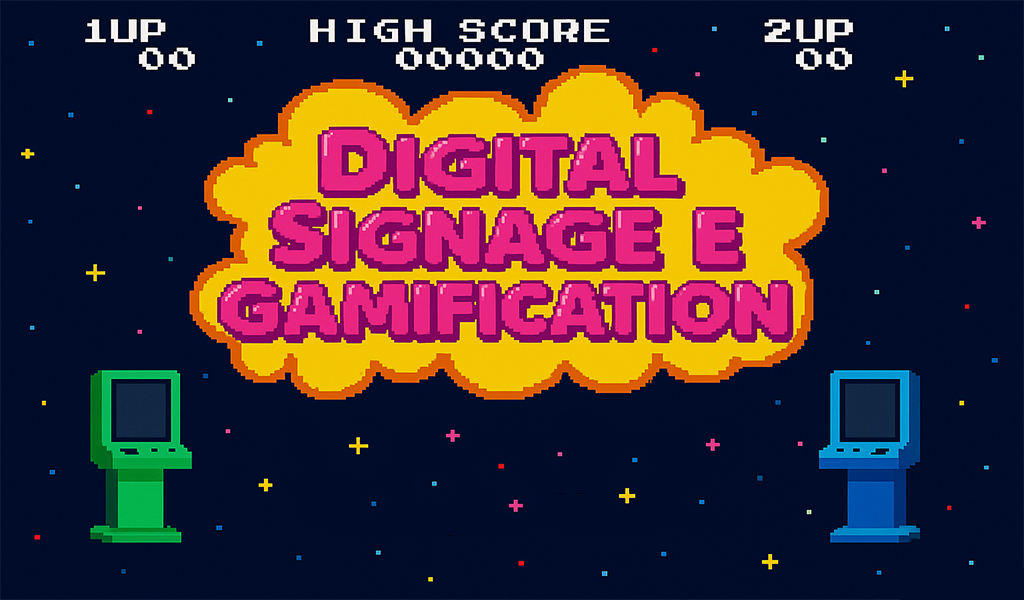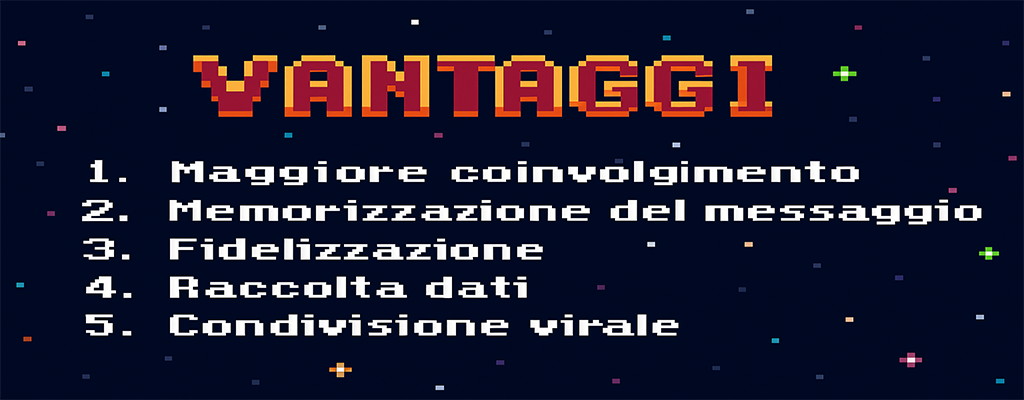
Digital Signage and gamification: fun ways to get people involved
In an era where the public’s attention is increasingly fragmented, catching the eye is not enough: you have to engage. This is where gamification comes in – the use of playful mechanics to stimulate participation and enhance the user experience. When this approach is fused with the visual and interactive potential of Digital Signage, the result is dynamic, memorable and highly effective communication. Read on to find out more.
What is gamification in Digital Signage?
Gamification applied to Digital Signage consists of integrating typical game elements – such as challenges, prizes, rankings or quizzes – within the content displayed on monitors or multimedia totems. The purpose? To transform the audience from passive viewer to active part of the experience.
In fact, the perspective, thanks to gamification, is reversed. It is no longer you who communicates something to the user, but it is the user who discovers, conquers and assimilates what you want to communicate through the game. In this way, he or she is also encouraged to further extend the experience through comments, sharing on social networks, participation in new initiatives. Thus you will have gained a valuable supporter of your brand, engaged and participating. Moreover, greater involvement and participation generates a more rooted and long-lasting loyalty relationship between customer and brand.
The role of interactivity
Interactivity is a key element of gamification in digital signage. By integrating touchscreens, motion sensors or mobile connectivity, digital signage can offer a personalised and immersive experience.
Furthermore, interactivity prolongs the time spent in front of the screen because by playing, one loses track of time. This, especially in the retail sector, makes the customer spend more time in the shop because even if the shop assistants are all busy, earning a voucher or a prize is a rewarding way to fill the waiting time.
For example, a retail shop might use interactive displays to allow customers to play a game that offers discounts or rewards upon completion.

Benefits of gamification in Digital Signage
- Greater involvement: the audience is attracted by the interactivity and the chance to test themselves. In addition, the game provides instant gratification: sound effects, words of encouragement are indications of victories that increase our motivation and push us to continue, game after game.
- Memorisation of the message: content experienced first-hand is remembered much longer.
- Loyalty: rewards and rewards incentivise return and repeated interaction. So do competition and immediate recognition of achievement. Each victory is merely an incentive to immediately pursue another.
- Data collection: every interaction and every game, compatible with privacy regulations, can generate useful insights into navigation, content visited and time spent in front of the monitor. Insights that can then be translated into concrete actions to improve the totem’s user experience and thus its performance.
- Viral sharing: well-designed gaming experiences stimulate spontaneous sharing on social networks.
Applications in different areas
At first glance, gamification would seem to lend itself only to retail contexts where the ultimate goal is sales or loyalty. In reality, it is perfectly suited to very different contexts.
- Retail and large-scale retail trade: at the point of sale, gamification can stimulate purchases, promote new products or make waiting more pleasant. From instant competitions in shopping centres to thematic quizzes in branded corners.
- Events and trade fairs: during trade fairs and events, gamified content on multimedia totems and monitors become a magnet for visitors. Companies can collect leads in an entertaining way and increase stand retention.
- Corporate environments: in the corporate environment, in-house digital signage can offer challenges between teams, training quizzes or rankings linked to performance targets.
- School and training: even in the educational world, gamification proves to be a powerful ally for making information content or institutional communications more engaging.

Golden rules for effective gamification
Integrating gamification into Digital Signage does not mean simply ‘adding a game’ to content: it means designing a tailor-made experience, consistent with the brand’s objectives and capable of generating real value. Here’s how best to do it:
Clear objective
Before even defining the dynamics of the game, it is crucial to establish the purpose of the initiative:
- Do you want to increase audience engagement at a point of sale?
- Are you trying to retain repeat customers?
- Do you want to collect useful data on behaviour and preferences?
- Each objective requires a different approach, and only a targeted design will guarantee measurable results.
Simplicity
An effective game is intuitive. The rules must be comprehensible within seconds, even by someone who absent-mindedly stops in front of a display. Avoid complex experiences or articulated mechanics: better a few well-designed elements than many difficult-to-understand steps. Simplicity is an ally of engagement.
Meaningful rewards
Rewards are a powerful trigger of motivation. They can be:
- Tangible rewards: discounts, gadgets, gift vouchers.
- Digital rewards: downloadable coupons, virtual badges.
- Social status: appearing in a ranking, receiving public recognition.
The important thing is that the reward is perceived as consistent with the commitment required and relevant to the target group. The wrong incentive risks nullifying the effect of the game.
Smooth integration with the brand
The game should not appear ‘tacked on’ to the corporate message. On the contrary, it should amplify it. The gaming experience must speak the same language as the brand, respect its tone of voice and enhance its mission:
- If you sell natural products, create sustainability-themed games.
- If you organise sports events, use competitive dynamics.
- If you promote technology, focus on interactivity and personalisation.
Attractive design
A game is judged first and foremost by its appearance. A neat, fluid, colourful, cleverly animated interface is what determines whether someone will choose to participate or not. The design must:
- Be visually consistent with the corporate identity
- Stimulate curiosity
- Guide the user step by step
Constant monitoring and analysis
Each interaction is a mine of data: number of participations, average play time, preferences expressed, conversion rates. Collecting and analysing this data is essential for:
- Measuring the effectiveness of the campaign
- Identify friction points
- Optimise future versions
By integrating a Digital Signage system with analytics software, it is possible to obtain detailed reports in real time, and turn each campaign into an evolutionary process.
The future of Digital Signage is interactive
Gamification transforms Digital Signage, which is no longer just a content container but a relationship space. Purpose-built UX and the integration of the latest technologies (such as sensors or webcams) make it possible to develop advanced game mechanics while actively involving the audience. Only in this way, in a reality overloaded with stimuli and information, is it possible to create memorable experiences and achieve concrete results in terms of attention, conversion and loyalty.
